List of Chinese cultural relics forbidden to be exhibited abroad
The list of Chinese cultural relics forbidden to be exhibited abroad (Chinese: 禁止出境展览文物; pinyin: Jìnzhǐ Chūjìng Zhǎnlǎn Wénwù) comprises a list of antiquities and archaeological artifacts held by various museums and other institutions in the People's Republic of China, which the Chinese government has officially prohibited, since 2003, from being taken abroad for exhibition. Many of the relics on the list symbolize the breakthrough of archaeological discoveries that were made in China since the mid-20th century, when archaeology as a modern science began to take root in China. These items are among the most important excavated treasures in China, and have a particular historical, cultural or artistic significance.
The list was first announced in January 2002, with a second batch of items added to the list in June 2012, and a third batch added the next year in July 2013.[1]
Government regulations prohibiting exhibition abroad
According to Article 49 of the Regulations for the Implementation of the Law of the People's Republic of China on Protection of Cultural Relics (State Council Decree No. 377) promulgated on 18 May 2003:
The only existing or fragile relics among the grade-one relics are prohibited from being taken out of the country for exhibition. The catalogue of cultural relics prohibited from being taken out of the country for exhibition shall be made public on a regular basis by the competent cultural relics administrative department of the State Council.[2][3]
A first list of sixty-four cultural relics that are forbidden to be exhibited abroad was published by the State Administration of Cultural Heritage on 19 January 2002 (a year before the above regulation was enacted).[4]
In addition to the list of items explicitly prohibited from being exhibited abroad, cultural relics that fall within one of the following five categories are also prohibited from being exhibited outside of China:[5]
- ancient human remains
- the main object of reverence at a place of religious observation
- first-grade cultural relics that are unique and easily damaged
- objects listed in the catalogue of cultural relics that are prohibited from being exhibited abroad
- cultural relics that are not suitable to be exhibited abroad because of their state of preservation
Furthermore, cultural relics may not be sent abroad for exhibition if they have not previously been officially exhibited within China.[2]
First batch (2002)
In 2002, the State Administration of Cultural Heritage announced its first list of 64 first-grade cultural relics that are forbidden to be taken out of mainland China for exhibition.[6][7]
| Name | Period | Place of discovery | Date of discovery | Collection | Image |
|---|---|---|---|---|---|
| Coloured pottery pot depicting a stork, a fish, and a stone axe 彩绘鹳鱼石斧图陶缸[8] | Neolithic | Ruzhou, Henan | 1978 | National Museum of China, Beijing |  |
| Pottery ding vessel in the form of an eagle, from the Yangshao culture 陶鹰鼎[9] | Neolithic | Hua County, Shaanxi | 1958 | National Museum of China, Beijing | 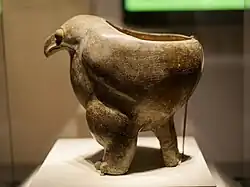 |
| Houmuwu ding 后母戊鼎[10] | Shang dynasty (1600–1046 BCE) | Anyang, Henan | 1939 | National Museum of China, Beijing |  |
| Li gui, a bronze wine cup with an inscription commemorating King Wu of Zhou's defeat of the Shang dynasty 利簋[11] | Western Zhou (1046–771 BCE) | Lintong, Shaanxi | 1976 | National Museum of China, Beijing |  |
| Da Yu ding, a bronze ding cauldron cast by Yu, with an inscription dated the 23rd year of the reign of King Kang of Zhou 大盂鼎[12] | Western Zhou (1046–771 BCE) | Qishan, Shaanxi | 1820–1850 | National Museum of China, Beijing |  |
| Guoji Zibai pan, a bronze trough with an inscription commemorating the defeat of Xianyun people by Duke Xuan of Guo in the 12th year of the reign of King Xuan of Zhou 虢季子白盘[13] | Western Zhou (1046–771 BCE) | Baoji, Shaanxi | 1820–1850 | National Museum of China, Beijing |  |
| Four phoenix crowns from the tomb of the Wanli Emperor 凤冠[14] | Ming dynasty (1368–1644) | Changping District, Beijing | 1957 | National Museum of China, Beijing |  |
| Ivory cup inlaid with turquoise, from the tomb of Fu Hao 嵌綠松石象牙杯[15] | Shang dynasty (1600–1046 BCE) | Anyang, Henan | 1976 | Chinese Academy of Social Sciences Institute of Archaeology |  |
| Jin Hou Su zhong, a set of 16 ceremonial bronze bianzhong bells from the tomb of Marquis Xian of Jin 晉侯蘇鍾[16] | Western Zhou (1046–771 BCE) | Quwo, Shanxi | Shanghai Museum | ||
| Da Ke ding, a bronze ding cauldron cast by Ke during the reign of King Xiao of Zhou 大克鼎[17] | Western Zhou (1046–771 BCE) | Fufeng, Shaanxi | 1890 | Shanghai Museum |  |
| Taibao ding, a bronze ding cauldron cast by the Duke of Shao during the reign of King Cheng of Zhou 太保鼎[18] | Western Zhou (1046–771 BCE) | Liangshan County, Shandong | mid 19th century | Tianjin Museum |  |
| Red lacquered bowl from the Hemudu culture 河姆渡出土朱漆碗[19] | Neolithic | Yuyao, Zhejiang | 1977 | Zhejiang Provincial Museum, Hangzhou | |
| Pottery stove from the Hemudu culture 河姆渡出土陶灶[20] | Neolithic | Yuyao, Zhejiang | 1977 | Zhejiang Provincial Museum, Hangzhou |  |
| Royal Jade cong from the Liangzhu culture 良渚出土玉琮王[21] | Neolithic | Yuhang, Zhejiang | 1986 | Zhejiang Institute of Archaeology |  |
| Warring States crystal glass 水晶杯[22] | Warring States period (475–221 BCE) | Hangzhou, Zhejiang | 1990 | Zhejiang Institute of Archaeology | |
| Bronze stand for ceremonial vessels from the tomb of the son of King Zhuang of Chu 淅川出土銅禁[23] | Spring and Autumn period (771–403 BCE) | Xichuan, Henan | 1978 | Henan Museum, Zhengzhou |  |
| Pair of square bronze jars from the tomb of the Duke of Zheng 新鄭出士蓮鶴銅方壺[24] | Spring and Autumn period (771–403 BCE) | Xinzheng, Henan | 1923 | Palace Museum, Beijing Henan Museum, Zhengzhou | 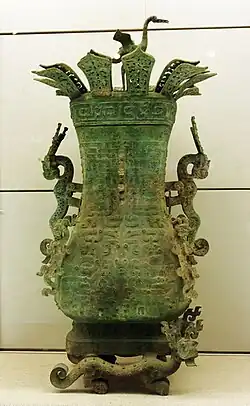 |
| Rectangular bronze mirror from the tomb of the Prince of Qi 齐王墓青铜方镜[25] | Western Han (206 BCE – 9 CE) | Zibo, Shandong | 1980 | Zibo Museum |  |
| Bronze ding vessel from the tomb of the King of Chu 铸客大铜鼎[26] | Warring States period (475–221 BCE) | Shou County, Anhui | 1933 | Anhui Provincial Museum, Hefei | 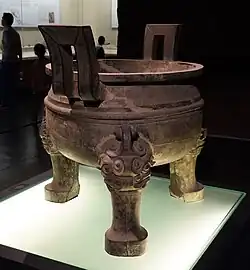 |
| Lacquered wooden platform shoes from the tomb of Zhu Ran 朱然墓出土漆木屐 | Three Kingdoms (Eastern Wu) | Ma'anshan, Anhui | 1984 | Zhu Ran Family Cemetery Museum | |
| Lacquered picture plate from the tomb of Zhu Ran 朱然墓出土贵族生活图漆盘[27] | Three Kingdoms (Eastern Wu) | Ma'anshan, Anhui | 1984 | Zhu Ran Family Cemetery Museum | |
| Painted lacquer wooden screen depicting scenes of filial sons and virtuous women in Chinese history, from the tomb of Sima Jinlong 司马金龙墓出土漆屏[28] | Northern Wei (386–534) | Datong, Shanxi | 1965 | Datong Museum |  |
| Mural depicting horse riders from the tomb of Lou Rui 娄睿墓鞍马出行图壁画[29] | Northern Qi (550–577) | Taiyuan, Shanxi | 1979 | Shanxi Institute of Archaeology |  |
| Memorial stone engraved with illustrations of Buddhist Stories 涅槃变相碑 | Tang dynasty (618–907) | Linyi, Shanxi | Shanxi Art Museum, Taiyuan |  | |
| Stone sculpture of a Daoist deity 常阳太尊石像 | Tang dynasty (618–907) | Yuncheng, Shanxi | Shanxi Art Museum, Taiyuan |  | |
| Jade ceremonial dagger-axe 大玉戈[30] | Shang dynasty (1600–1046 BCE) | Wuhan, Hubei | 1974 | Hubei Provincial Museum, Wuhan[30] |  |
| Bianzhong of Marquis Yi of Zeng[31] | Warring States period (475–221 BCE) | Sui County, Hubei | 1978 | Hubei Provincial Museum, Wuhan |  |
| Carved and lacquered wooden outer coffin from the tomb of Marquis Yi of Zeng 曾侯乙墓外棺[32] | Warring States period (475–221 BCE) | Sui County, Hubei | 1978 | Hubei Provincial Museum, Wuhan | 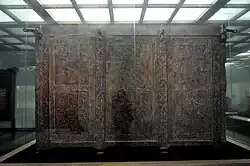 |
| Pair of intricately decorated bronze food and wine vessels cast using the lost-wax process from the tomb of Marquis Yi of Zeng 曾侯乙青铜尊盘[33] | Warring States period (475–221 BCE) | Sui County, Hubei | 1978 | Hubei Provincial Museum, Wuhan | 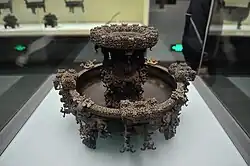 |
| Wooden screen with carved images of phoenixes and deer, decorated with polychromatic lacquer 彩漆木雕小座屏[34] | Warring States period (475–221 BCE) | Jiangling, Hubei | 1965 | Hubei Provincial Museum, Wuhan |  |
| Clay sculpture of the head of a goddess, inlaid with jade eyes, from the Hongshan culture temple at Niuheliang 红山文化女神像[35] | Neolithic | Lingyuan, Liaoning | 1983 | Liaoning Institute of Archaeology | |
| Duck-shaped glass object 鸭形玻璃注[36] | Northern Yan (407–436) | Beipiao, Liaoning | 1965 | Liaoning Province Museum, Shenyang |  |
| 4 metre tall bronze tree with a dragon curling up the trunk, and leaves, fruit and birds on the branches 青铜神树[37] | Shang dynasty (1600–1046 BCE) | Guanghan, Sichuan | 1986 | Sanxingdui Museum | 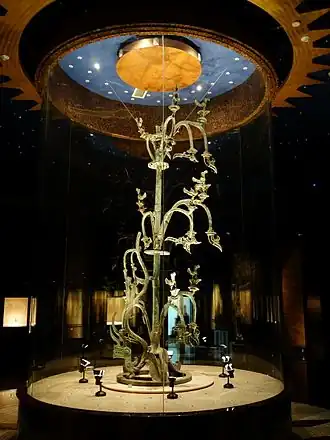 |
| Ceremonial jade object with engraved drawings of stylized human figures 三星堆出土玉边璋[38] | Shang dynasty (1600–1046 BCE) | Guanghan, Sichuan | 1986 | Sanxingdui Museum |  |
| 2 metre tall bronze money tree with a phoenix perched at the top 摇钱树[39] | Eastern Han (25–220) | Mianyang, Sichuan | 1990 | Mianyang Museum |  |
| Gansu Flying Horse 铜奔马[40] | Eastern Han (25–220) | Wuwei, Gansu | 1969 | Gansu Provincial Museum, Lanzhou |  |
| The Qin bronze chariots, from the Mausoleum of the First Qin Emperor 铜车马[41] | Qin dynasty (221–206 BCE) | Lintong, Shaanxi | 1980 | Museum of the Terracotta Warriors and Horses of Qin Shihuang, Lintong |  |
| Shi Qiang pan[42] 牆盤 | Western Zhou (1046–771 BCE) | Fufeng, Shaanxi | 1967 | Baoji Bronzeware Museum |  |
| Large bronze ding vessel with three handles and ox-head decoration 淳化大鼎[43] | Western Zhou (1046–771 BCE) | Chunhua, Shaanxi | 1979 | Chunhua Museum | |
| Bronze He zun, with an inscription recording the construction of the capital at Luoyang by King Cheng of Zhou[44] 何尊 | Western Zhou (1046–771 BCE) | Baoji, Shaanxi | 1963 | Baoji Bronzeware Museum |  |
| Stone sculptures from the tomb of Huo Qubing at the mausoleum of Emperor Wu of Han at Maoling 茂陵石雕[45] | Western Han (206 BCE – 9 CE) | Xianyang, Shaanxi | Maoling Museum, Xianyang | ||
| Xi'an Stele — a stele recording the introduction of Christianity into China in 635 大秦景教流行中国碑[46] | Tang dynasty (618–907) | Shaanxi | 1623 | Xi'an Beilin Museum, Xi'an |  |
| Gilt silver jug imitating the shape of a leather water bottle, with a design of prancing horses Hejia Village hoard 舞马衔杯仿皮囊式银壶[47] | Tang dynasty (618–907) | Xi'an, Shaanxi | 1970 | Shaanxi History Museum, Xi'an | 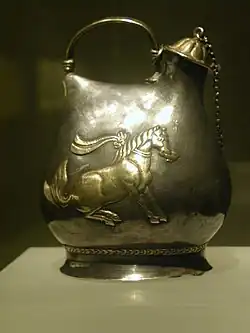 |
| Zoomorphic drinking horn made from agate Hejia Village hoard 兽首玛瑙杯[48] | Tang dynasty (618–907) | Xi'an, Shaanxi | 1970 | Shaanxi History Museum, Xi'an |  |
| Bronze bell cast in 711, weighing 6,500 kg, originally from the bell tower at the Tang capital Chang'an 景云铜钟[49] | Tang dynasty (618–907) | Xi'an Beilin Museum, Xi'an |  | ||
| Gilt and silvered monk's staff donated to Famen Temple by Emperor Yizong of Tang in 873 银花双轮十二环锡杖[50] | Tang dynasty (618–907) | Fufeng, Shaanxi | 1987 | Famen Temple Museum, Fufeng |  |
| Set of eight nested relic boxes containing a relic supposed to be a finger bone from Śākyamuni Buddha, from Famen Temple 八重宝函[51] | Tang dynasty (618–907) | Fufeng, Shaanxi | 1987 | Famen Temple Museum, Fufeng |  |
| Bronze model pagoda from Famen Temple 铜浮屠[52] | Tang dynasty (618–907) | Fufeng, Shaanxi | 1987 | Famen Temple Museum, Fufeng | |
| "Five stars rising in the East" armband "五星出东方"护膊[53] | Eastern Han (25–220) to Jin (266–420) | Minfeng, Xinjiang | 1995 | Xinjiang Institute of Archaeology |  |
| Bronze table frame inlaid with gold and silver, decorated with figures of four dragons and four phoenixes 错金银四龙四凤铜方案座[54] | Warring States period (475–221 BCE) | Pingshan, Hebei | 1974 | Hebei Museum, Shijiazhuang[54] | 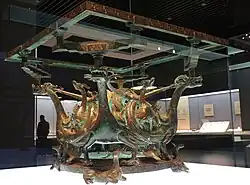 |
| Bronze ding vessel with iron feet from the tomb of the King of Zhongshan 中山王铁足铜鼎[55] | Warring States period (475–221 BCE) | Pingshan, Hebei | 1977 | Hebei Museum, Shijiazhuang[55] | 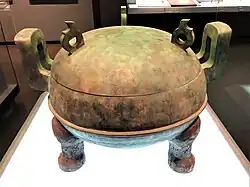 |
| Jade burial suit from the tomb of Liu Sheng, Prince of Zhongshan 刘胜金缕玉衣[56] | Western Han (206 BCE – 9 CE) | Mancheng, Hebei | 1968 | Hebei Museum, Shijiazhuang |  |
| Gilt bronze lamp in the shape of a serving girl, from the tomb of Lady Dou Wan 长信宫灯[57] | Western Han (206 BCE – 9 CE) | Mancheng, Hebei | 1968 | Hebei Museum, Shijiazhuang |  |
| Five bronze pieces from an otherwise decayed folding screen, from the tomb of the King of Nanyue 铜屏风构件5件[58] | Western Han (206 BCE – 9 CE) | Guangzhou, Guangdong | 1983 | Museum of the Mausoleum of the Nanyue King, Guangzhou | |
| Horn-shaped jade cup from the tomb of the King of Nanyue 角形玉杯[59] | Western Han (206 BCE – 9 CE) | Guangzhou, Guangdong | 1983 | Museum of the Mausoleum of the Nanyue King, Guangzhou |  |
| Silk painting depicting a man riding a dragon 人物御龙帛画[60] | Warring States period (475–221 BCE) | Changsha, Hunan | 1949 | Hunan Provincial Museum, Changsha |  |
| Silk painting depicting a man with a dragon and a phoenix 人物龙凤帛画[61] | Warring States period (475–221 BCE) | Changsha, Hunan | 1949 | Hunan Provincial Museum, Changsha |  |
| Plain gauze robe from the tomb of the Marquis of Dai at Mawangdui 直裾素纱禅衣[62] | Western Han (206 BCE – 9 CE) | Changsha, Hunan | 1972 | Hunan Provincial Museum, Changsha |  |
| Wooden outer coffin from the tomb of the Marquis of Dai at Mawangdui 马王堆一号墓木棺椁 | Western Han (206 BCE – 9 CE) | Changsha, Hunan | 1972 | Hunan Provincial Museum, Changsha | 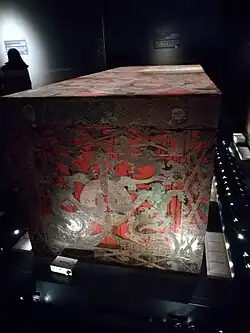 |
| T-shaped silk funeral banner from the tomb of the Marquis of Dai at Mawangdui 马王堆一号墓T型帛画[63] | Western Han (206 BCE – 9 CE) | Changsha, Hunan | 1972 | Hunan Provincial Museum, Changsha |  |
| Brocade banner depicting the Sun God and hunting scenes 红地云珠日天锦[64] | Northern dynasties (386–581) | Dulan, Qinghai | 1983 | Qinghai Institute of Archaeology | |
| Nine volumes of Buddhist texts written in the Tangut language that were printed using wooden movable type, from Baisigou Square Pagoda 西夏文佛经《吉祥遍至口和本续》纸本[65] | Western Xia (1038–1227) | Helan, Ningxia | 1991 | Ningxia Institute of Archaeology | 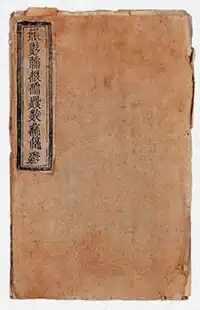 |
| Red-glazed pottery model of a granary 青花釉里红瓷仓[66] | Yuan dynasty (1271–1368) | Jingdezhen, Jiangxi | 1974 | Jiangxi Provincial Museum, Nanchang | |
| Picture of the Seven Sages of the Bamboo Grove composed from more than 300 moulded bricks 竹林七贤砖印模画[67] | Southern dynasties (420–589) | Nanjing, Jiangsu | 1960 | Nanjing Museum |  |
Second batch (2012)
In June 2012, the State Administration of Cultural Heritage announced the second batch of 37 cultural relics forbidden to be exhibited abroad, covering paintings and works of calligraphy.[68]
| Name | Period | Collection | Image |
|---|---|---|---|
| Pingfu Tie by Lu Ji 陆机《平复帖》卷 | Western Jin (266–316) | Palace Museum, Beijing | 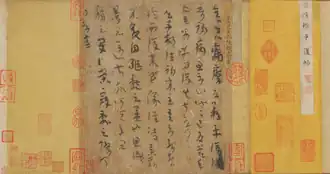 |
| Boyuan Tie by Wang Xun 王珣《伯远帖》卷 | Eastern Jin (317–420) | Palace Museum, Beijing | 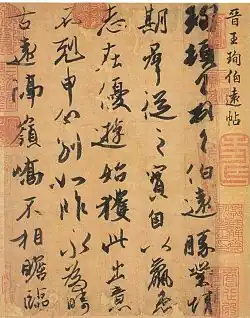 |
| Imitation of Wang Xizhi's Lanting Xu by Feng Chengsu 冯承素摹王羲之《兰亭序》卷 | Tang dynasty (618–907) | Palace Museum, Beijing |  |
| Mengdian Tie by Ouyang Xun 欧阳询《梦奠帖》卷 | Tang dynasty (618–907) | Liaoning Provincial Museum, Shenyang | |
| Shanjian Lü by Guo Quan 国诠《善见律》卷 | Tang dynasty (618–907) | Palace Museum, Beijing | |
| Kuxun Tie by Huaisu 怀素《苦筍帖》卷 | Tang dynasty (618–907) | Shanghai Museum | 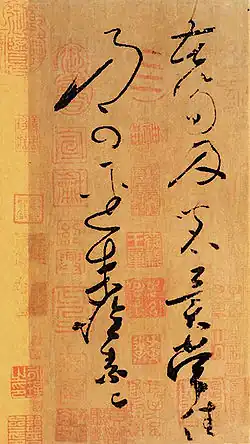 |
| Poem of Zhang Haohao by Du Mu 杜牧《张好好诗》卷 | Tang dynasty (618–907) | Palace Museum, Beijing | |
| Tang imitation of Wang Xizhi's Yimen Shuhan 唐人《摹王羲之一门书翰》卷 | Tang dynasty (618–907) | Liaoning Provincial Museum, Shenyang | |
| Method of Daily Life that Leads to Immortality by Yang Ningshi 杨凝式《神仙起居法帖》卷 | Five Dynasties (907–960) | Palace Museum, Beijing | |
| Self-written Poem by Lin Bu 林逋《自书诗》卷 | Northern Song (960–1127) | Palace Museum, Beijing | |
| Self-written Poem by Cai Xiang 蔡襄《自书诗》卷 | Northern Song (960–1127) | Palace Museum, Beijing | |
| Santie Juan by Wen Yanbo 文彦博《三帖卷》 | Northern Song (960–1127) | Palace Museum, Beijing | |
| Correspondence written in semi-cursive and regular script by Han Qi 韩琦《行楷信札卷》卷 | Northern Song (960–1127) | Guizhou Provincial Museum, Guiyang | |
| Primer to the Surangama Sutra by Wang Anshi 王安石《楞严经旨要》卷 | Northern Song (960–1127) | Shanghai Museum | |
| Zhushangzuo by Huang Tingjian 黄庭坚《诸上座》卷 | Northern Song (960–1127) | Palace Museum, Beijing | |
| Poem of Tiao Creek by Mi Fu 米芾《苕溪诗》卷 | Northern Song (960–1127) | Palace Museum, Beijing | |
| Thousand Character Classic in Cursive Script by Zhao Ji 赵佶《草书千字文》卷 | Northern Song (960–1127) | Liaoning Provincial Museum, Shenyang |  |
| Stroll About in Spring by Zhan Ziqian 展子虔《游春图》卷 | Sui dynasty (581–618) | Palace Museum, Beijing |  |
| Five Oxen by Han Huang 韩滉《五牛图》卷 | Tang dynasty (618–907) | Palace Museum, Beijing | |
| Court Ladies Waving Fans by Zhou Fang 周昉《挥扇仕女图》卷 | Tang dynasty (618–907) | Palace Museum, Beijing | _Liaoning_Provincial_Museum%252C_Shenyang..jpg) |
| Gao Yi Tu by Sun Wei 孙位《高逸图》卷 | Tang dynasty (618–907) | Shanghai Museum | |
| Kan Shu Tu by Wang Qihan 王齐翰《勘书图》卷 | Five Dynasties (907–960) | Nanjing University | |
| Chess Meeting with Double Screens by Zhou Wenju 周文矩《重屏会棋图》卷 | Five Dynasties (907–960) | Palace Museum, Beijing |  |
| Rest Stop for the Khan by Hu Gui 胡瓌《卓歇图》卷 | Five Dynasties (907–960) | Palace Museum, Beijing | |
| The Night Revels of Han Xizai by Gu Hongzhong 顾闳中《韩熙载夜宴图》卷 | Five Dynasties (907–960) | Palace Museum, Beijing |  |
| Gao Shi Tu by Wei Xian 卫贤《高士图》卷 | Five Dynasties (907–960) | Palace Museum, Beijing |  |
| Waiting for Ferry in Summer Mountains by Dong Yuan 董源《山口待渡图》卷 | Five Dynasties (907–960) | Liaoning Provincial Museum, Shenyang | |
| The Sketching of Rare Birds by Huang Quan 黄筌《写生珍禽图》卷 | Five Dynasties (907–960) | Palace Museum, Beijing |  |
| Light Snow on a Fishing Village by Wang Shen 王诜《渔村小雪图》卷 | Northern Song (960–1127) | Palace Museum, Beijing | |
| Reeds Riverbank Covered by Heavy Snow by Liang Shimin 梁师闵《芦汀密雪图》卷 | Northern Song (960–1127) | Palace Museum, Beijing | |
| Pasturing Horses (After Wei Yan) by Li Gonglin 李公麟《摹韦偃牧放图》卷 | Northern Song (960–1127) | Palace Museum, Beijing | |
| Pasturing Horses among the Rivers and Mountains by Qi Xu 祁序《江山牧放图》卷 | Northern Song (960–1127) | Palace Museum, Beijing | |
| Along the River During the Qingming Festival by Zhang Zerui 张择端《清明上河图》卷 | Northern Song (960–1127) | Palace Museum, Beijing | _par_Zhang_Zeduan.jpg) |
| A Thousand Li of Rivers and Mountains by Wang Ximeng 王希孟《千里江山图》卷 | Northern Song (960–1127) | Palace Museum, Beijing | |
| Latter Ode to the Red Cliff by Ma Hezhi 马和之《后赤壁赋图》卷 | Southern Song (1127–1279) | Palace Museum, Beijing | |
| Golden Halls in Pine Forest by Zhao Bosu 赵伯骕《万松金阙图》卷 | Southern Song (1127–1279) | Palace Museum, Beijing | |
| Song imitation of Yan Liben's Emperor Taizong Receiving the Tibetan Envoy 宋人摹阎立本《步辇图》卷 | Song dynasty (960–1279) | Palace Museum, Beijing | .jpg) |
Third batch (2013)
On 31 July 2013, a third batch of 94 items were announced, including treasures excavated at archaeological sites such as bronzes, pottery, jades, and others.[1]
| Name | Period | Place of discovery | Date of discovery | Collection | Image |
|---|---|---|---|---|---|
| Zilong ding 子龙鼎 | Shang dynasty (1600–1046 BCE) | Purportedly Huixian, Henan | 1920s | National Museum of China, Beijing |  |
| Four-goat Square Zun 四羊方尊 | Shang dynasty (1600–1046 BCE) | Ningxiang, Hunan | 1938 | National Museum of China, Beijing |  |
| Bronze horn-shaped sigong (wine vessel) with dragon motif 龙纹兕觥 | Shang dynasty (1600–1046 BCE) | Shilou, Shanxi | 1959 | Shanxi Museum, Taiyuan |  |
| Da He ding 大禾方鼎 | Shang dynasty (1600–1046 BCE) | Ningxiang, Hunan | 1959 | Hunan Museum | _with_human_faces.jpg) |
| Bronze Standing Figure 铜立人像 | Shang dynasty (1600–1046 BCE) | Sanxingdui site, Guanghan, Sichuan | 1986 | Sanxingdui Museum | 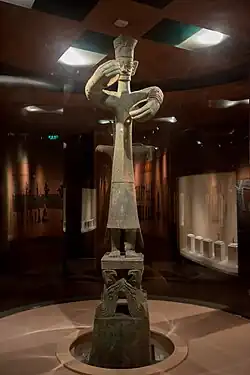 |
| Tianwang gui 天亡簋 | Western Zhou (1046–771 BCE) | National Museum of China, Beijing |  | ||
| Bo Ju li 伯矩鬲 | Western Zhou (1046–771 BCE) | Liulihe site, Beijing | 1975 | Capital Museum, Beijing |  |
| Bird-shaped zun of the Marquis of Jin State 晋侯鸟尊 | Western Zhou (1046–771 BCE) | Quwo, Shanxi | 1992 | Shanxi Museum, Taiyuan | |
| Hu gui 㝬簋 | Western Zhou (1046–771 BCE) | Fufeng, Shaanxi | 1978 | Baoji Bronzeware Museum |  |
| Lai pan 逨盘 | Western Zhou (1046–771 BCE) | Mei County, Shaanxi | 2003 | Baoji Bronzeware Museum | |
| Sword of Goujian 越王勾践剑 | Spring and Autumn period (771–403 BCE) | Jiangling, Hubei | 1965 | Hubei Provincial Museum, Wuhan |  |
| Bronze square sheng of Shang Yang 商鞅方升 | Warring States period (475–221 BCE) | Shanghai Museum | 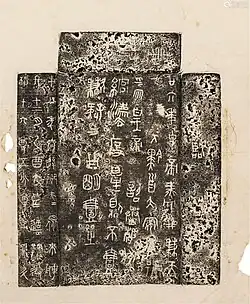 | ||
| Bronze hu inlaid with gold and silver netting cover 错金银镶嵌丝网套铜壶 | Warring States period (475–221 BCE) | Xuyi, Jiangsu | 1982 | Nanjing Museum | |
| Bronze Cowrie Container with Sacrificial Ceremony Scene 诅盟场面贮贝器 | Western Han (206 BCE – 9 CE) | Shizaishan site, Jinning, Yunnan | National Museum of China, Beijing |  | |
| Mirror painted with people, chariots, and horses 彩绘人物车马镜 | Western Han (206 BCE – 9 CE) | Xi'an, Shaanxi | 1963 | Xi'an Museum | |
| Bronze Cowrie Container with a Pillar-Sacrificial Scene 杀人祭柱场面贮贝器 | Western Han (206 BCE – 9 CE) | Shizaishan site, Jinning, Yunnan | Yunnan Provincial Museum, Kunming | 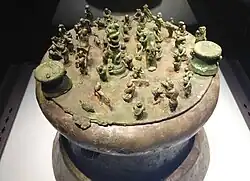 | |
| Human-faced fish decoration pottery bowl, Yangshao culture 仰韶文化彩陶人面鱼纹盆 | Neolithic | Banpo site, Xi'an, Shaanxi | 1955 | National Museum of China, Beijing |  |
| Pottery basin painted with groups of dancing figures, Majiayao culture 马家窑文化彩陶舞蹈纹盆 | Neolithic | Datong, Qinghai | 1973 | National Museum of China, Beijing |  |
| Painted pottery jar with nude figure, Majiayao culture 马家窑文化彩陶贴塑人纹双系壶 | Neolithic | Ledu, Qinghai | 1974 | National Museum of China, Beijing | |
| Boat-form pottery flask painted with reticulated pattern, Yangshao culture 仰韶文化彩陶网纹船形壶 | Neolithic | Beishouling site, Baoji, Shaanxi | 1958 | National Museum of China, Beijing |  |
| Pottery basin with painted coiled dragon pattern, Longshan culture 龙山文化彩绘蟠龙纹陶盘 | Neolithic | Taosi site, Xiangfen, Shanxi | 1980 | Institute of Archaeology, Chinese Academy of Social Sciences | 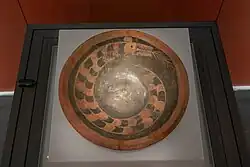 |
| Human-form pottery jar, Yangshao culture 仰韶文化彩陶人形双系瓶 | Neolithic | Dadiwan site, Qin'an, Gansu | 1973 | Gansu Provincial Museum, Lanzhou |  |
| Dou saucer with the design of octagonal starstreak, Dawenkou culture 大汶口文化彩陶八角星纹豆 | Neolithic | Dawenkou site, Tai'an, Shandong | 1974 | Shandong Museum | 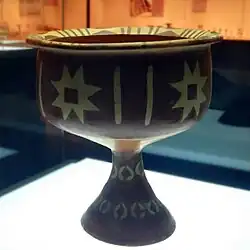 |
| Celadon gucang urn marked "3rd year of the Yong'an era" (AD 260) “永安三年”款青釉堆塑谷仓罐 | Three Kingdoms (Eastern Wu, 229–280) | Shaoxing, Zhejiang | 1935 | Palace Museum, Beijing | |
| Celadon tiger-shaped chamber pot marked "14th year of the Chiwu era" (AD 251) “赤乌十四年”款青釉虎子 | Three Kingdoms (Eastern Wu, 229–280) | Nanjing, Jiangsu | 1955 | National Museum of China, Beijing |  |
| Celadon underglaze porcelain vase with winged figures 青釉褐彩羽人纹双系壶 | Three Kingdoms (Eastern Wu, 229–280) | Nanjing, Jiangsu | 1983 | Nanjing Municipal Museum | |
| Celadon glazed porcelain zun with design of a monster 青釉神兽尊 | Western Jin (266–316) | Tomb of Zhou Chu, Yixing, Jiangsu | 1976 | Nanjing Museum | 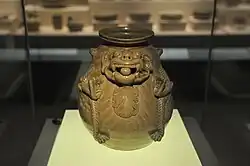 |
| Green glazed vase covered with lotus designs 青釉仰覆莲花尊 | Northern Qi (550–577) | Jing County, Hebei | 1948 | National Museum of China, Beijing | 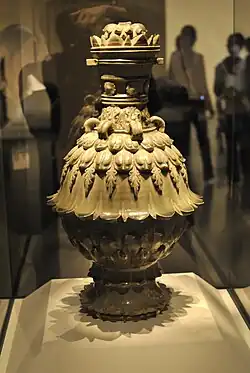 |
| Green glazed white porcelain vase with long neck 白釉绿彩长颈瓶 | Northern Qi (550–577) | Tomb of Fan Cui, Anyang, Henan | 1971 | Henan Museum, Zhengzhou | .jpg) |
| White-glazed double-bellied vase with double dragon-shaped handles, Sui dynasty 隋白釉龙柄双联传瓶 | Sui dynasty (581–618) | Tianjin Museum | 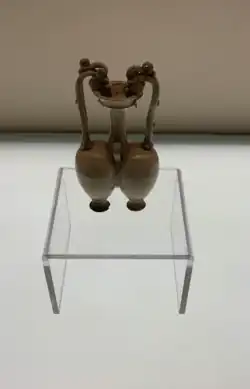 | ||
| Green-glazed dragon-handled vase with phoenix top 青釉凤首龙柄壶 | Tang dynasty (618–907) | Palace Museum, Beijing | |||
| Speckle-glazed waist drum, Lushan ware 鲁山窑黑釉蓝斑腰鼓 | Tang dynasty (618–907) | Palace Museum, Beijing |  | ||
| Polychrome glazed tomb figurine of a troupe of musicians on a camel 陶骆驼载乐舞三彩俑 | Tang dynasty (618–907) | Tomb of Xianyu Tinghai, Xi'an, Shaanxi | 1957 | National Museum of China, Beijing |  |
| Brown-green-color celadon jar, Changsha ware 长沙窑青釉褐蓝彩双系罐 | Tang dynasty (618–907) | Yangzhou, Jiangsu | 1974 | Yangzhou Museum | |
| Five-legged celadon censer with cloud patterns, Yue ware 越窑青釉褐彩云纹五足炉 | Tang dynasty (618–907) | Lin'an, Zhejiang | 1980 | Lin'an Museum |  |
| Brown speckled porcelain ewer with dancing figure design, Changsha ware 长沙窑青釉褐彩贴花人物纹壶 | Tang dynasty (618–907) | Hengyang, Hunan | 1973 | Hunan Museum |  |
| Sancai musicians on camel 三彩骆驼载乐俑 | Tang dynasty (618–907) | Xi'an, Shaanxi | 1959 | Shaanxi History Museum, Xi'an |  |
| Water bowl in the shape of a makara, Yaozhou ware 耀州窑摩羯形水盂 | Five Dynasties (907–960) | Beipiao, Liaoning | 1971 | Liaoning Provincial Museum, Shenyang | 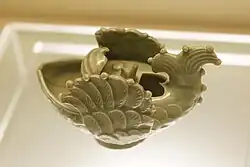 |
| Lotus flower-styled saucer, Yue ware 越窑莲花式托盏 | Five Dynasties (907–960) | Tiger Hill Pagoda, Suzhou, Jiangsu | 1956 | Suzhou Museum |  |
| Celadon glazed cadogan-type pot with flower carvings and handle, Yaozhou ware 耀州窑青釉刻花提梁倒流壶 | Five Dynasties (907–960) | Bin County, Shaanxi | 1968 | Shaanxi History Museum, Xi'an | |
| Light-sky-blue glazed zun container with bowstring patterns, Ru ware 汝窑天青釉弦纹樽 | Northern Song (960–1127) | Palace Museum, Beijing |  | ||
| Celadon vase with bowstring patterns, Guan ware 官窑弦纹瓶 | Northern Song (960–1127) | Palace Museum, Beijing | 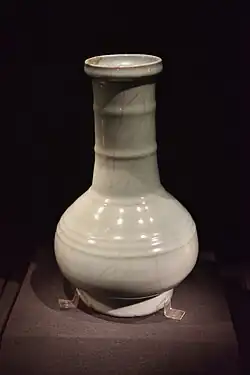 | ||
| Moon-white glazed zun vessel with vertical ridges 钧窑月白釉出戟尊 | Northern Song (960–1127) | Palace Museum, Beijing |  | ||
| White-glazed kundika with lotus blossom design and dragon head, Ding ware 定窑白釉刻莲花瓣纹龙首净瓶 | Northern Song (960–1127) | Underground Palace of the Jingzhongyuan Pagoda, Ding County, Hebei | 1969 | Dingzhou Museum | |
| Zun vase with tubular lug handles, Guan ware 官窑贯耳尊 | Northern Song (960–1127) | Jilin Provincial Museum, Changchun | |||
| Vase with tiger and leopard design against a pearl-patterned backdrop, Dengfeng ware 登封窑珍珠地划花虎豹纹瓶 | Song dynasty (960–1279) | Palace Museum, Beijing | |||
| Blue-and-white meiping with depiction of the story of Xiao He pursuing Han Xin under the moon 青花萧何月下追韩信图梅瓶 | Yuan dynasty (1271–1368) | Tomb of Mu Ying, Nanjing, Jiangsu | Nanjing Municipal Museum |  | |
| Blue glazed meiping with white dragon 蓝釉白龙纹梅瓶 | Yuan dynasty (1271–1368) | Yangzhou Museum | |||
| Jade dragon, Hongshan culture 红山文化玉龙 | Neolithic | Ongniud Banner, Inner Mongolia | 1971 | National Museum of China, Beijing |  |
| Jade ax with divine figure and beast carvings, Liangzhu culture 良渚文化神人兽面纹玉钺 | Neolithic | Yuhang, Zhejiang | 1986 | Zhejiang Provincial Museum, Hangzhou | |
| Jade knife with seven holes 七孔玉刀 | Xia dynasty (c. 2070 – c. 1600 BCE) | Erlitou site, Yanshi, Henan | 1975 | Erlitou Site Museum of the Xia Capital, Luoyang | 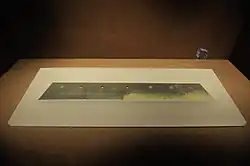 |
| Jade pendant of the Jin marchioness 晋侯夫人组玉佩 | Western Zhou (1046–771 BCE) | Tomb of the secondary wife of the Marquis Mu of Jin, Quwo, Shanxi | 1992 | Shanxi Museum, Taiyuan | .jpg) |
| Dragon-phoenix pendent ornament in 16 parts 多节活环套练玉佩 | Warring States period (475–221 BCE) | Tomb of Marquis Yi of Zeng, Sui County, Hubei | 1978 | Hubei Provincial Museum, Wuhan |  |
| Jade seal with characters "Huanghou zhi xi" (Seal of the Empress) “皇后之玺”玉玺 | Western Han (206 BCE – 9 CE) | Near the Han Changling, Xianyang, Shaanxi | 1968 | Shaanxi History Museum, Xi'an | 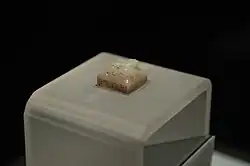 |
| Jade openwork table screen with King Father of the East and Queen Mother of the West carvings 镂雕东王公西王母纹玉座屏 | Eastern Han (25–220) | Tomb of Liu Chang, Dingzhou, Hebei | 1969 | Dingzhou Museum | |
| Jade container with carvings of deities and beasts 神兽纹玉樽 | Western Jin (266–316) | Tomb of Liu Hong, Anxiang, Hunan | 1991 | Hunan Museum |  |
| Jade seal with dragon knob bearing the characters "Tongling Shijiao Dayuan Guoshi zhi yin" (Seal of the Great Yuan State Preceptor presiding over the Siddhartha sect) “统领释教大元国师之印”龙钮玉印 | Yuan dynasty (1271–1368) | Tibet Museum, Lhasa | |||
| Golden Sun Bird 太阳神鸟金箔片 | Shang dynasty (1600–1046 BCE) | Jinsha site, Chengdu, Sichuan | 2001 | Jinsha Site Museum |  |
| Golden sceptre 金杖 | Shang dynasty (1600–1046 BCE) | Sanxingdui site, Guanghan, Sichuan | 1986 | Sanxingdui Museum |  |
| Silver belt buckle with inlaid gold and jade 包金镶玉嵌琉璃银带钩 | Warring States period (475–221 BCE) | Huixian, Henan | 1951 | National Museum of China, Beijing |  |
| Gold seal with characters "Dian wang zhi yin" (Seal of the Dian king) “滇王之印”金印 | Western Han (206 BCE – 9 CE) | Shizhaishan site, Jinning, Yunnan | 1956 | National Museum of China, Beijing |  |
| Copper umbrella collar with gold and silver inlay and turquoise hunting pattern 错金银镶松石狩猎纹铜伞铤 | Western Han (206 BCE – 9 CE) | Hebei Provincial Institute of Cultural Relics and Archaeology | |||
| Gilt-silver wine-drinking game set "The Analects Jade Candle” atop a tortoise with inscribed drinking strips 龟负论语玉烛酒筹鎏金银筒 | Tang dynasty (618–907) | Dantu, Jiangsu | 1982 | Zhenjiang Museum | |
| Lacquer box in the shape of a mandarin duck 彩绘乐舞图鸳鸯形漆盒 | Warring States period (475–221 BCE) | Tomb of Marquis Yi of Zeng, Sui County, Hubei | 1978 | Hubei Provincial Museum, Wuhan | 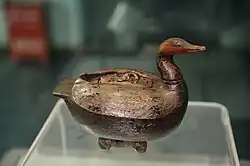 |
| Rectangular casket with lacquered shallow relief with gilt painting 识文彩绘盝顶长方形漆奁 | Western Han (206 BCE – 9 CE) | Mawangdui site, Changsha, Hunan | 1973 | Hunan Museum |  |
| Lacquered liubo chess set 黑漆朱绘六博具 | Western Han (206 BCE – 9 CE) | Mawangdui site, Changsha, Hunan | 1973 | Hunan Museum |  |
| Lacquered tray with painted depiction of Jizha hanging his sword 彩绘季札挂剑图漆盘 | Three Kingdoms (Eastern Wu, 229–280) | Tomb of Zhu Ran, Ma'anshan, Anhui | 1984 | Anhui Provincial Institute of Cultural Relics and Archaeology | |
| Leather cup with gilded copper ear lacquered in the "rhinoceros hide" technique (2 pieces) 皮胎犀皮漆鎏金铜釦耳杯(2件) | Three Kingdoms (Eastern Wu, 229–280) | Tomb of Zhu Ran, Ma'anshan, Anhui | 1984 | Anhui Provincial Institute of Cultural Relics and Archaeology | |
| Pearl Pillar of the Buddhist Shrine (including the wooden box) 木雕真珠舍利宝幢(含木函) | Northern Song (960–1127) | Pagoda of Ruiguang Temple, Suzhou, Jiangsu | 1978 | Suzhou Museum |  |
| Ivory comb, Dawenkou culture 大汶口文化象牙梳 | Neolithic | Dawenkou site, Tai'an, Shandong | 1959 | National Museum of China, Beijing | 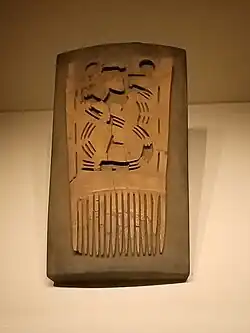 |
| Ivory burin with the pattern of two birds facing the sun 河姆渡文化双鸟朝阳纹象牙雕刻器 | Neolithic | Hemudu site, Yuyao, Zhejiang | 1977 | Zhejiang Provincial Museum, Hangzhou | |
| Green glass container with lid 绿玻璃盖罐 | Sui dynasty (581–618) | Tomb of Li Jingxun, Xi'an, Shaanxi | 1957 | National Museum of China, Beijing | 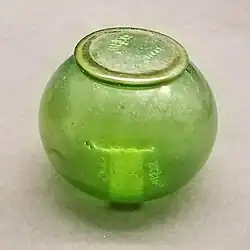 |
| Small green glass vase 绿玻璃小瓶 | Sui dynasty (581–618) | Tomb of Li Jingxun, Xi'an, Shaanxi | 1957 | National Museum of China, Beijing |  |
| Red woolen caftan with decorative patterns of nude putti, animals and pomegranate trees worn by the Yingpan man 红地对人兽树纹罽袍 | Han dynasty (202 BC – 220 AD) | Yuli County, Xinjiang | 1995 | Institute of Cultural Relics and Archaeology in Xinjiang |  |
| Embroidered donor portrait with Buddhist imagery 刺绣佛像供养人 | Northern Wei (386–534) | Mogao Caves, Dunhuang, Gansu | 1965 | Dunhuang Research Academy | |
| Brocade of animal against checkered background 方格兽纹锦 | Northern dynasties (386–581) | Astana Cemetery, Turpan, Xinjiang | 1968 | Xinjiang Uyghur Autonomous Region Museum, Urumqi | |
| Brocade with Holy Eagles Pattern 灵鹫纹锦袍 | Northern Song (960–1127) | Aral, Xinjiang | 1953 | Palace Museum, Beijing | |
| Stone drums (set of 10) 石鼓(1组10只) | Warring States period (475–221 BCE) | Palace Museum, Beijing | _of_the_Palace_Museum%252C_2017-05-21.jpg) | ||
| Six Steeds of Zhao Mausoleum stone reliefs (The four panels of Shifachi, Baitiwu, Telebiao, and Qingzhui) 昭陵六骏石刻(什伐赤、白蹄乌、特勒骠、青骓4幅) | Tang dynasty (618–907) | Xi'an Beilin Museum |   | ||
| Rubbings of the Xiyue Temple Stele (Huayin edition) 拓西岳华山庙碑册(华阴本) | Song dynasty (960–1279) | Palace Museum, Beijing | |||
| Rubbing of the Cao Quan Stele (Copy with "yin" character undamaged) 曹全碑初拓本(“因”字不损本) | Ming dynasty (1368–1644) | Shanghai Museum |  | ||
| Kanmiu Buque Qieyun manuscript by Wang Renxu 写本王仁煦《刊谬补缺切韵》 | Tang dynasty (618–907) | Palace Museum, Beijing | |||
| Block-printed Avivartiya text from the Kaibao Canon (1 volume) 刻开宝藏本《阿惟越致经》(1卷) | Northern Song (960–1127) | National Library of China, Beijing | |||
| Block-printed Collected Works of Fan Zhongyan 刻本《范仲淹文集》(20卷) | Northern Song (960–1127) | National Library of China, Beijing | |||
| "Polo players at their game" mural of Prince Zhanghuai's tomb (1 set) 章怀太子墓壁画马球图(1组) | Tang dynasty (618–907) | Shaanxi History Museum, Xi'an |  | ||
| "Hunting scene" mural from Prince Zhanghuai's tomb (1 set) 章怀太子墓壁画狩猎出行图(1组) | Tang dynasty (618–907) | Shaanxi History Museum, Xi'an | |||
| Gate tower mural from Prince Yide's tomb (1 set) 懿德太子墓壁画阙楼图(1组) | Tang dynasty (618–907) | Shaanxi History Museum, Xi'an |  | ||
| Court ladies mural from Princess Yongtai's tomb (1 set) 永泰公主墓壁画宫女图(1组) | Tang dynasty (618–907) | Shaanxi History Museum, Xi'an |  | ||
| "Jin Teng" chapter from the Tsinghua Warring States bamboo slips 戰國简《金縢》 | Warring States period (475–221 BCE) | Tsinghua University | |||
| Laozi bundles A, B, and C of the Guodian Chu Slips 郭店楚简《老子(甲、乙、丙)》 | Warring States period (475–221 BCE) | Jingmen Museum |  | ||
| Kongzi Shilun from the Shanghai Chu slips 楚简《孔子诗论》 | Warring States period (475–221 BCE) | Shanghai Museum |  | ||
| Yushu from the Shuihudi Qin bamboo texts 云梦睡虎地秦简《语书》 | Qin dynasty (221–206 BCE) | Hubei Provincial Museum, Wuhan | |||
| Mathematical text Shu from the Qin bamboo manuscripts in the possession of the Yuelu Academy 秦简《数》 | Qin dynasty (221–206 BCE) | Hunan University | |||
| The Changes of Zhou of the Mawangdui Han Tomb Silk Texts 马王堆汉墓帛书《周易》 | Western Han (206 BCE – 9 CE) | Hunan Museum |
Footnotes
- ^ a b 94件一级文物列入"第三批禁止出境展览文物目录" (in Chinese). Chinanews. 19 August 2013. Retrieved 3 February 2015.
- ^ a b Regulations for the Implementation of the Law of the People's Republic of China on Protection of Cultural Relics, State Administration of Cultural Heritage, 29 October 2007, archived from the original on 19 March 2012
- ^ 中华人民共和国文物保护法实施条例, The Central People's Government of the People's Republic of China, 23 May 2005
- ^ 中国文物事业改革开放30年, State Administration of Cultural Heritage, 29 December 2008, archived from the original on 19 March 2012, retrieved 16 September 2011
- ^ 文物出境展览管理规定, State Administration of Cultural Heritage, 28 October 2007, archived from the original on 19 March 2012, retrieved 16 September 2011
- ^ 国家文物局发出通知 首批一级文物禁止出国(境)展览, The Chinese Cultural Heritage Protection Web Site
- ^ 国家文物局发出通知 首批一级文物禁止出国(境)展览, Beijing Global Culture Information Technology, archived from the original on 2015-09-23, retrieved 2011-09-16
- ^ "彩绘鹳鱼石斧图陶缸". The Chinese Cultural Heritage Protection Web Site.
- ^ "陶鹰鼎". The Chinese Cultural Heritage Protection Web Site.
- ^ "司母戊铜鼎". The Chinese Cultural Heritage Protection Web Site.
- ^ "利簋". The Chinese Cultural Heritage Protection Web Site.
- ^ "大盂鼎". The Chinese Cultural Heritage Protection Web Site.
- ^ "虢季子白盘". The Chinese Cultural Heritage Protection Web Site.
- ^ "凤冠". The Chinese Cultural Heritage Protection Web Site.
- ^ "嵌绿松石象牙杯". The Chinese Cultural Heritage Protection Web Site.
- ^ "晋侯苏钟". The Chinese Cultural Heritage Protection Web Site.
- ^ "大克鼎". The Chinese Cultural Heritage Protection Web Site.
- ^ "太保鼎". The Chinese Cultural Heritage Protection Web Site.
- ^ "河姆渡出土朱漆碗". The Chinese Cultural Heritage Protection Web Site.
- ^ "河姆渡土"陶灶"". The Chinese Cultural Heritage Protection Web Site.
- ^ "良渚出土玉琮王". The Chinese Cultural Heritage Protection Web Site.
- ^ "水晶杯". The Chinese Cultural Heritage Protection Web Site.
- ^ "淅川出土云纹铜禁". The Chinese Cultural Heritage Protection Web Site.
- ^ "新郑出土莲鹤铜方壶". The Chinese Cultural Heritage Protection Web Site.
- ^ "齐王墓青铜方镜". The Chinese Cultural Heritage Protection Web Site.
- ^ "铸客大铜鼎". The Chinese Cultural Heritage Protection Web Site.
- ^ "朱然墓出土贵族生活图漆盘". The Chinese Cultural Heritage Protection Web Site.
- ^ "司马金龙墓出土漆屏". The Chinese Cultural Heritage Protection Web Site.
- ^ "娄睿墓鞍马出行图壁画". The Chinese Cultural Heritage Protection Web Site.
- ^ a b "Treasures in Hubei Provincial Museum". General Office of Hubei Provincial People’s Government.
- ^ "曾侯乙编钟". The Chinese Cultural Heritage Protection Web Site.
- ^ "曾侯乙墓外棺". The Chinese Cultural Heritage Protection Web Site.
- ^ "曾侯乙青铜尊盘". The Chinese Cultural Heritage Protection Web Site.
- ^ "彩漆木雕小座屏". The Chinese Cultural Heritage Protection Web Site.
- ^ "红山文化女神像". The Chinese Cultural Heritage Protection Web Site.
- ^ "鸭形玻璃注". The Chinese Cultural Heritage Protection Web Site.
- ^ "青铜神树". The Chinese Cultural Heritage Protection Web Site.
- ^ "三星堆出土玉边璋". The Chinese Cultural Heritage Protection Web Site.
- ^ "摇钱树". The Chinese Cultural Heritage Protection Web Site.
- ^ "铜奔马". The Chinese Cultural Heritage Protection Web Site.
- ^ "铜车马". The Chinese Cultural Heritage Protection Web Site.
- ^ "墙盘". The Chinese Cultural Heritage Protection Web Site.
- ^ "淳化大鼎". The Chinese Cultural Heritage Protection Web Site.
- ^ "何尊". The Chinese Cultural Heritage Protection Web Site.
- ^ "茂陵石雕". The Chinese Cultural Heritage Protection Web Site.
- ^ "大秦景教流行中国碑". The Chinese Cultural Heritage Protection Web Site.
- ^ "舞马衔杯仿皮囊式银壶". The Chinese Cultural Heritage Protection Web Site.
- ^ "兽首玛瑙杯". The Chinese Cultural Heritage Protection Web Site.
- ^ "景云铜钟". The Chinese Cultural Heritage Protection Web Site.
- ^ "银花双轮十二环锡杖". The Chinese Cultural Heritage Protection Web Site.
- ^ "八重宝函". The Chinese Cultural Heritage Protection Web Site.
- ^ "铜浮屠". The Chinese Cultural Heritage Protection Web Site.
- ^ ""五星出东方"护膊". The Chinese Cultural Heritage Protection Web Site.
- ^ a b "错金银四龙四凤铜方案座". Hebei Museum.
- ^ a b "中山王铁足大铜鼎". Hebei Museum.
- ^ "刘胜金缕玉衣". The Chinese Cultural Heritage Protection Web Site.
- ^ "长信宫灯". The Chinese Cultural Heritage Protection Web Site.
- ^ "铜屏风构件5件". The Chinese Cultural Heritage Protection Web Site.
- ^ "角形玉杯". The Chinese Cultural Heritage Protection Web Site.
- ^ "人物御龙帛画". The Chinese Cultural Heritage Protection Web Site.
- ^ "人物龙凤帛画". The Chinese Cultural Heritage Protection Web Site.
- ^ "直裾素纱禅衣". The Chinese Cultural Heritage Protection Web Site.
- ^ "马王堆一号墓T型帛画". The Chinese Cultural Heritage Protection Web Site.
- ^ "红地云珠日天锦". The Chinese Cultural Heritage Protection Web Site.
- ^ "西夏文佛经《吉祥遍至口本续》纸本". The Chinese Cultural Heritage Protection Web Site.
- ^ "青花釉里红瓷仓". The Chinese Cultural Heritage Protection Web Site.
- ^ "竹林七贤砖印模画". The Chinese Cultural Heritage Protection Web Site.
- ^ 第二批禁止出国(境)展览文物目录(书画类) (in Chinese). State Administration of Cultural Heritage. 11 June 2012. Retrieved 3 February 2015.














